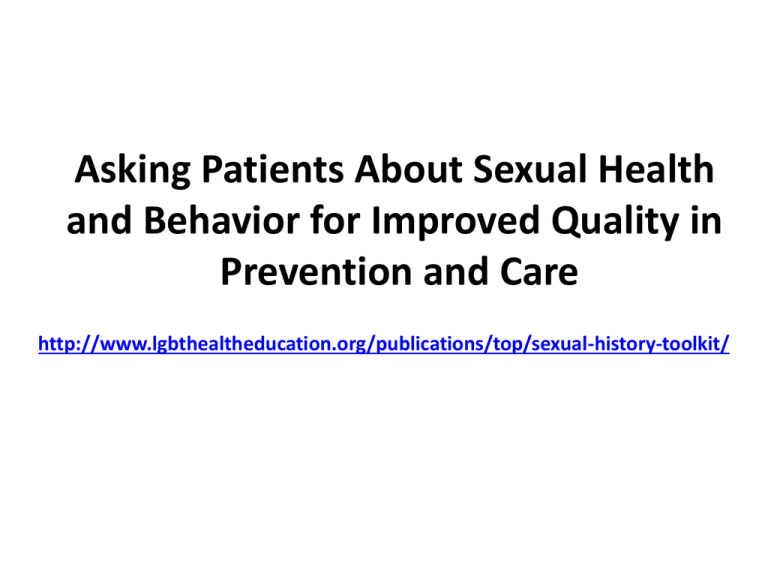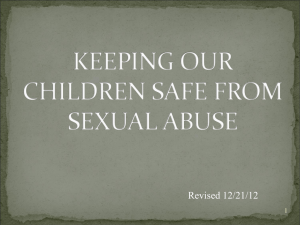
Asking Patients About Sexual Health
and Behavior for Improved Quality in
Prevention and Care
http://www.lgbthealtheducation.org/publications/top/sexual-history-toolkit/
Overview
– This PowerPoint presentation has been developed
for an all-staff training. This training can also be
included in new-employee orientations.
• Health center leadership should gather all
staff together to
• 1) demonstrate their commitment to taking routine
histories of sexual health;
• 2) present the need and importance of sexual history
information; and
• 3) explain the systems that will be implemented for
routine sexual history taking.
Why Ask About Sexual Health and
Behavior?
• Learning about the sexual health and behavior
of patients is an important part of what health
centers do every day:
•
•
•
•
provide high-quality
safe
accessible, and
efficient health care.
How Can We Learn about Patients’
Sexual Health and Behavior?
Providers, or other members of the clinical care team,
should ask all adolescent and adult patients about their
sexual health and behavior as part of the routine
history. The sexual history for adults generally begins
with these three screening questions, with follow-up as
appropriate:
– 1. Have you been sexually active in the last six months?
– 2. Have you had sex with women, men, or both?
– 3. How many people have you had sex with in the past
year?
The Sexual History Is Prevention
• Taking a history of sexual health allows us to find and
treat sexually transmitted diseases (STDs) that may
otherwise be missed.
• If left untreated, many STDs:
– can lead to more serious illnesses, infertility, and possibly
death
– can spread to other partners and increase disease in the
community.
• Taking a sexual history also gives us the opportunity
to talk with patients about ways they can stay
healthy.
Taking a Sexual History Helps Us
Improve Our Patients’ Overall Health
• Preventing and treating STDs, HIV, and hepatitis, can
help us reduce disease and death among our
patients.
• Identifying and treating sexual problems and low
sexual satisfaction can help us improve our patients’
mental health and well-being.
• When we show our patients that we are interested in
and compassionate about their sexual problems,
behaviors, and identity, we will see an improvement
in our relationship with patients.
The Sexual History Helps Us to Be
Patient-Centered
In a survey of 500 men and women over age 25:
– 85% said they were interested in talking to their
doctors about sexual issues
– 71% thought their doctor would likely dismiss their
concerns.1
The sexual history allows health centers to identify
clinical needs early and provide clinically and costeffective care – essential elements of a patient
centered medical home (PCMH).
1Marwick
C. Survey says patients expect little physician help on sex. JAMA. 1999;281:2173-4.
Who Is This For?
All of our patients!
Sexual history information should be taken from
all of our patients, regardless of gender, race,
ethnicity, socioeconomic status, sexual
orientation or gender identity.
Who Will Be Involved?
All of our staff!
All health center staff have a role in making sure
that sexual histories are completed in an
accurate, appropriate, sensitive, and
confidential manner throughout the patient
visit.
When Are Sexual Histories Taken?
• The sexual history is taken as part of the general
history during the annual prevention visit, or in
response to questions or symptoms.
• It can be taken by the provider or other member of
the clinical care team during the visit.
• Or, much can be filled out by the patient on paper or
electronically in advance of the visit, and then
reviewed during the visit.
Why Now?
• There are new national plans to reduce HIV
infections and hepatitis infections.
• Taking routine sexual histories are necessary for
meeting the goals of these national plans.
• These plans rely on community health centers
because we serve populations with a greater risk of
becoming infected with HIV and hepatitis.
Who is at Greater Risk? (U.S. Data)
• African American men and women
– 45% of HIV infections
– Twice as likely to have hepatitis C compared to
rest of US population
• Hispanic men and women
– 22% of HIV infections
• Asian/Pacific Islander men and women
– 1 in 12 are living with hepatitis B
Who is at Greater Risk? (U.S. Data)
• Men who have sex with men (MSM) (gay and
bisexual men, and men who have male partners but
do not identify as being gay or bisexual)
• 64% of new HIV infections
• 37% of HIV+ MSM are African American (48% increase
from 2006-9)
• 15%–25% of all new Hepatitis B virus infections
• Frequent reports of Hepatitis A outbreaks
• Transgender women (people born male who feel
very strongly that their gender is female, and who
express themselves as women)
• 28% estimated to be HIV infected (57% of African
American transgender women)
Providing Care To Patients Who
Are Gay, Bisexual, Or Transgender
• The greater risk of hepatitis and HIV in these populations
makes it especially critical that a routine sexual history is
taken for all patients to help identify those most at risk and
then provide appropriate screening and prevention
counseling
– CDC has specific screening and testing recommendations for MSM,
due to their higher risk
– The sexual history should be inclusive of all sexual behaviors and be
taken without judgment
• Culturally competent care for gay, bisexual, transgender and
lesbian patients will help patients feel safe to disclose full
histories to their providers, allowing them to receive clinically
effective care. Trainings and resources are available.
Asking about Sexual Orientation
and Gender Identity
• In addition to taking a sexual history, asking all
patients about their sexual orientation and gender
identity is now recommended by the:
– Institute of Medicine and
– the Joint Commission
• as a way to improve the care of lesbian, gay, bisexual,
and transgender people
• and overcome a wide range of health disparities,
including risk for diseases like HIV and hepatitis.
Who Will Be Involved? Examples
Of Roles
• Leadership: Build routine sexual histories into strategic planning process
and staff education program; foster a culture of acceptance and respect
for all sexual behaviors and identities
• Medical Staff: Take and document regular histories; peer review of sexual
history taking; appropriately communicate medically necessary
information with the clinical care team
• Front Desk and Patient Services: Practice sensitive and confidential
collection of forms and communication with patients; master data
collection systems
• Administrative Staff: Revise intake and history forms; develop plan and
assign staff person to develop metrics and track data for measuring
progress; ensure that outreach materials, brochures, and other materials
include images and information that reflect people who are LGBT
Who Will Be Involved? Examples
Of Roles
• IT: Develop confidential systems that will include sexual
history and sexual orientation and gender identity data in
electronic records; train staff in systems
• Human Resources: Create and implement policies that
support non-discrimination and confidentiality around sexual
behaviors and identity ; integrate cultural competency
training into new employee orientations and annual trainings
• Finance: Work with medical staff to ensure cost-effective
coding and reimbursement for sexual history screenings
• All: Become familiar with confidentiality requirements,
policies protecting patient privacy, and policies regarding
discrimination; take trainings that teach about LGBT cultural
competency
How Will We Know How We’re
Doing?
• Possible Metrics (taken at 0, 6, and 12 months):
– Track number of sexual histories taken and documented, and the
number of patients screened for HIV, Hepatitis A, B, and C
– Compare screening rates to community or state data
– Track meaningful use measures, including the number of diagnoses,
number in care and treatment, and the number of patients with cooccurring disorders
– On patient experience survey, ask how well health center is taking
care of patient’s sexual health and how friendly or inviting the health
center is toward LGBT patients.
• By the 12th month, evaluate whether all relevant policies and
forms have language that is inclusive of LGBT identities and
behaviors.
Who Can We Partner With?
• Organizations that can help with trainings, resources, data and
systems:
–
–
–
–
–
–
–
–
–
Schools and school-based programs
Churches
State or County Health Department
AIDS Education and Training Centers
Bureau of Primary Health Care’s National Cooperative Agreements for
training and TA
STD and HIV clinics and support groups
Private providers
Academic Health Centers
Community centers and groups that support LGBT people
What’s Next?
• Small group review of the sexual history
toolkit
• Begin implementation
Thank you!









